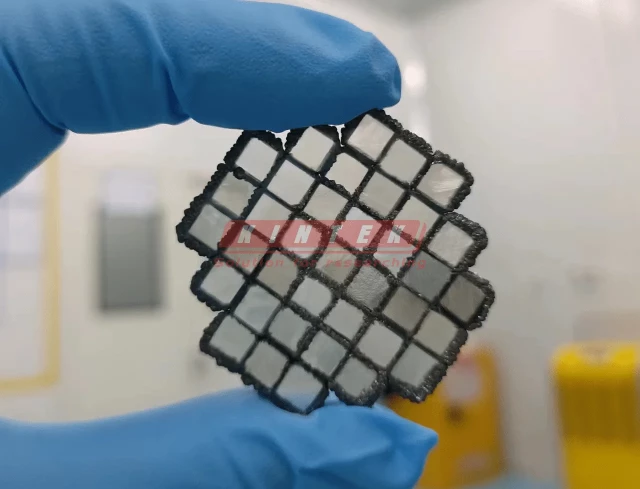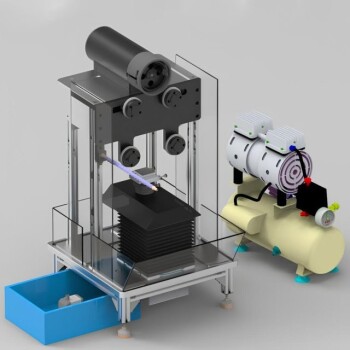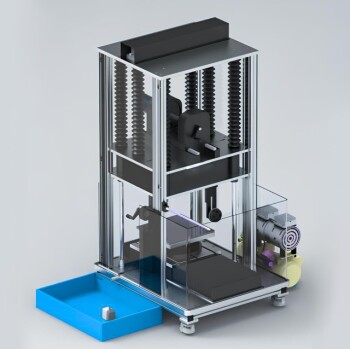Introduction to CVD Diamond Creation Process
CVD (Chemical Vapor Deposition) diamond creation process involves the deposition of carbon atoms onto a substrate using a gas phase chemical reaction. The process starts with the selection of a high-quality diamond seed, which is then placed in a growth chamber along with a carbon-rich gas mixture. The gas mixture is heated to a high temperature, causing the carbon atoms to dissociate and deposit onto the diamond seed, forming a diamond layer. This process is repeated multiple times until the desired diamond thickness is achieved. The CVD method offers several advantages over traditional diamond manufacturing, including the ability to create large and complex diamond shapes and the use of less energy and fewer resources.
Table of Contents
- Introduction to CVD Diamond Creation Process
- Importance of Selecting a Clean Diamond Seed
- Building CVD Diamond Machines
- Comparison between HPHT and CVD Diamond Manufacturing
- Different Types of CVD for Diamond Manufacturing
- Benefits of CVD over Traditional Diamond Manufacturing
- Colored Fancy Diamonds and Trace Elements
Importance of Selecting a Clean Diamond Seed
The CVD diamond machine is a highly sophisticated piece of equipment used in the production of synthetic diamonds. Understanding how this machine works is crucial to producing high-quality diamonds. The process involves the use of a diamond seed, which acts as a starting point for the growth of the synthetic diamond.
Why is selecting a clean diamond seed important?
The importance of selecting a clean diamond seed cannot be overstated, as any impurities or defects in the seed can affect the quality of the final product. This diamond seed is typically taken from a high-quality diamond created by HPHT. A thin slice of diamond, around 300 microns thick and 10x10mm is selected, and thoroughly cleaned. The diamond seed must be clean, as any trace elements or imperfections will be crystallized during CVD diamond growth, creating inclusions and blemishes.
How to select a clean diamond seed?
The selection of a clean diamond seed requires careful consideration. The seed must be free from any impurities and must have a high level of purity. The seed should also be free from any visible defects such as cracks, inclusions, or other imperfections that may affect the final product's quality. The shape of the seed is also important, as it will determine the shape of the final diamond.
What happens if an unclean diamond seed is used?
If an unclean diamond seed is used, it can result in the growth of a low-quality diamond. Impurities in the seed, such as nitrogen, can cause the synthetic diamond to have a yellow or brownish tint. The presence of inclusions or blemishes in the seed can also affect the final product's clarity.
In conclusion, selecting a clean diamond seed is essential for producing high-quality synthetic diamonds using the CVD diamond machine. The seed must be free from any impurities or defects to ensure the final product's quality and purity. Careful consideration should be given to the selection of the diamond seed, as it can significantly impact the final product's overall quality.
Building CVD Diamond Machines
CVD diamond machines are highly specialized equipment that are used to produce synthetic diamonds. Building these machines requires a deep understanding of the underlying chemical processes involved, as well as a thorough knowledge of vacuum technology, materials science, and engineering principles. Here's a step-by-step guide on how CVD diamond machines are built:
Step 1: Building the Vacuum Chamber
The process of building a CVD diamond machine begins with constructing a vacuum chamber. The chamber is designed to create a low-pressure environment that allows the diamond growth process to occur. The chamber must be carefully constructed and tested to ensure that it can maintain the required vacuum pressure.
Step 2: Preparing the Substrate
Once the vacuum chamber is built, a substrate is prepared. The substrate is typically made of silicon, and is coated with a thin layer of carbon. This carbon layer serves as the starting point for the diamond growth process.
Step 3: Heating the Substrate
The substrate is then placed in the vacuum chamber and heated to high temperatures, usually around 800-1000°C. This high temperature is necessary to initiate the diamond growth process.
Step 4: Introducing the Gas Mixture
A gas mixture of hydrogen and methane is then introduced into the vacuum chamber. These gases react in the chamber and create a plasma, which breaks down the carbon layer on the substrate. The carbon atoms then begin to bond together to form diamond crystals on the surface of the substrate.
Step 5: Growing the Diamond Film
As the diamond crystals grow, they gradually form a diamond film that can be harvested and used for a wide range of applications. The diamond film can be grown to a specific thickness and size depending on the requirements of the application.
Comparison between HPHT and CVD Diamond Manufacturing
When it comes to manufacturing diamonds, there are two main methods: HPHT and CVD. While both methods create synthetic diamonds, there are some key differences that make them unique. In this section, we will compare the two methods and highlight their advantages and disadvantages.
HPHT Diamond Manufacturing
HPHT stands for high pressure high temperature and is a method of creating synthetic diamonds by mimicking the natural conditions in which diamonds form. This method involves subjecting carbon to high pressure and temperature in the presence of a catalyst metal to create diamond crystals. The process is energy-intensive, and the equipment required is expensive. Moreover, HPHT diamonds are limited in size and shape due to the constraints of the manufacturing process. However, the advantage of HPHT diamonds is that they tend to have fewer impurities than CVD diamonds.
CVD Diamond Manufacturing
CVD stands for chemical vapor deposition and is a process that involves introducing hydrocarbon gas into a chamber that contains a substrate, typically a silicon or diamond wafer. The gas is then ionized, and the carbon atoms are deposited onto the substrate, creating a diamond layer. Compared to HPHT, CVD is less time-consuming and expensive. CVD diamonds can be made in larger sizes and shapes, while HPHT diamonds are limited in size and shape due to the constraints of the manufacturing process. However, CVD diamonds tend to have impurities such as silicon inclusions and can exhibit strong and unusual fluorescence characteristics when compared to natural diamonds.
Comparison of Advantages and Disadvantages
In summary, HPHT diamonds tend to have fewer impurities, while CVD diamonds can be made in larger sizes and shapes. HPHT requires high pressure and temperature to create diamonds, while CVD can create diamonds at atmospheric pressure and lower temperatures. The equipment required for HPHT is expensive, while CVD is less expensive and less time-consuming. However, HPHT is more established and has been in use for longer, while CVD is a newer technology that is still being developed. Ultimately, the choice of which method to use depends on the specific application and requirements.
In conclusion, both HPHT and CVD diamond manufacturing methods have their advantages and disadvantages. Understanding the differences between these two methods is crucial for anyone interested in the field of laboratory equipment or the diamond industry.
Different Types of CVD for Diamond Manufacturing
There are different types of CVD machines that are used for diamond manufacturing, each with its own unique process and conditions. These machines include hot filament, microwave plasma, and DC arc plasma.
Hot Filament
The hot filament CVD machine uses a tungsten filament that is heated to high temperatures. A mixture of hydrogen and methane gases is then passed over the filament, which breaks down the gases into their constituent atoms. The carbon atoms are then deposited onto the substrate, where they bond together to form diamond crystals.
Microwave Plasma
The microwave plasma CVD machine uses microwaves to create plasma, which then deposits carbon onto a substrate. This process involves introducing a mixture of gases, typically methane and hydrogen, into a vacuum chamber. The gases are then ionized using microwaves, creating a plasma that breaks down the gases into their constituent atoms. The carbon atoms are then deposited onto the substrate, where they bond together to form diamond crystals.

DC Arc Plasma
The DC arc plasma CVD machine uses a high-powered electric arc to create a plasma, which then deposits carbon onto a substrate. This process involves introducing a mixture of gases into a vacuum chamber, typically methane and hydrogen. An electric arc is then struck between two electrodes, creating a plasma that breaks down the gases into their constituent atoms. The carbon atoms are then deposited onto the substrate, where they bond together to form diamond crystals.
Each of these CVD machines can produce high-quality diamonds with varying properties, depending on the specific process and conditions used. Understanding the different types of CVD machines and how they work is important in the field of laboratory equipment, as it allows for the creation of synthetic diamonds with specific properties and applications, such as in the semiconductor and electronics industries.
Benefits of CVD over Traditional Diamond Manufacturing
The CVD diamond machine has revolutionized the diamond industry by providing a sustainable and ethical solution to diamond production while maintaining the same quality and durability as a natural diamond. Here are some of the benefits of CVD over traditional diamond manufacturing:
Greater Control Over Final Product
One of the significant benefits of CVD over traditional diamond manufacturing methods is its ability to produce high-quality diamonds with greater control over the final product’s shape, size, and color. CVD diamonds can be grown with consistent quality and uniformity in thickness, allowing for precise control over the final product.
Ethically Sourced
CVD diamonds are ethically sourced, with no environmental impact, unlike traditional mining methods. The process of mining diamonds has a significant impact on the environment, and it is often associated with unethical labor practices. CVD diamonds, on the other hand, are produced in a controlled laboratory environment, eliminating the need for mining and its associated environmental and ethical concerns.
Cost-Effective
The CVD diamond machine offers a more cost-effective solution to diamond production, as it requires less labor and time, making it an attractive option for many industries, including the jewelry industry. The cost of producing CVD diamonds is significantly lower than that of mining natural diamonds, making them an excellent option for those looking for high-quality diamonds at a more affordable price.
Quality and Durability
CVD diamonds have the same quality and durability as natural diamonds, possessing the same internal structure, chemical makeup, and physical lustrous beauty. CVD diamond properties include great durability, reaching 10 of the Mohs scale of hardness, and intense brilliance and sparkle, just like natural diamonds.
In conclusion, the CVD diamond machine has numerous benefits over traditional diamond manufacturing methods, making it an attractive option for many industries. The ability to produce high-quality diamonds with greater control over the final product’s shape, size, and color, coupled with ethically sourced and cost-effective production, makes CVD diamonds an excellent alternative to natural diamonds.
Colored Fancy Diamonds and Trace Elements
The CVD diamond machine uses the Chemical Vapor Deposition process to create synthetic diamonds, including colored fancy diamonds. These diamonds are produced by adding trace elements such as boron or nitrogen to the diamond structure during the CVD process. The trace elements are added to the gas mixture used to create the plasma in the reaction chamber.
The CVD Process
The process starts by placing a substrate in the reaction chamber, which is then heated to a high temperature. A mixture of hydrogen and methane gas is introduced into the chamber, and the plasma is created by applying a radio frequency energy. The plasma breaks down the gas molecules, and the carbon atoms are deposited onto the substrate, forming a diamond layer. The addition of trace elements to the gas mixture during the plasma process creates colored diamonds.
Colors of CVD Diamonds
The color of CVD diamonds can be altered by the addition of different trace elements to the gas mixture. For example, nitrogen can create yellow diamonds, while boron can create blue diamonds. Green diamonds can be created by radiation causing the carbon atoms in the crystal structure to deviate from their normal position. Large carat pink-blue-yellow diamonds are now available, some with very good color.
Advantages of CVD Diamonds
The CVD diamond machine has revolutionized the diamond industry, making it possible to produce high-quality diamonds in a fraction of the time and cost of traditional mining methods. Additionally, the CVD process allows for the creation of diamonds with unique colors and characteristics that are not found in natural diamonds. The ability to control the color of the diamonds produced by the CVD process is a significant advantage over natural diamonds, which are limited in terms of color availability.
In conclusion, the CVD diamond machine has opened up new possibilities for the diamond industry by allowing the production of synthetic diamonds with unique colors and characteristics. The addition of trace elements during the Chemical Vapor Deposition process allows for the creation of colored fancy diamonds, which were previously only available in natural form. With the continued development of this technology, the future looks bright for the diamond industry.
Related Products
- Laboratory CVD Boron Doped Diamond Materials
- CVD Diamond for Thermal Management Applications
- 915MHz MPCVD Diamond Machine Microwave Plasma Chemical Vapor Deposition System Reactor
- Inclined Rotary Plasma Enhanced Chemical Vapor Deposition PECVD Equipment Tube Furnace Machine
- CVD Diamond Cutting Tool Blanks for Precision Machining














